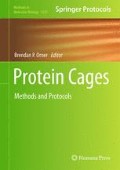Abstract
Ultracentrifugation, particularly the use of sucrose or cesium chloride density gradients, is a highly reliable and efficient technique for the purification of virus-like particles and protein cages. Since virus-like particles and protein cages have a unique size compared to cellular macromolecules and organelles, the rate of migration can be used as a tool for purification. Here we describe a detailed protocol for the purification of recently discovered virus-like assemblies called bacterial encapsulins from Thermotoga maritima and Brevibacterium linens.
Access this chapter
Tax calculation will be finalised at checkout
Purchases are for personal use only
References
Liu Z, Qiao J, Niu Z, Wang Q (2012) Natural supramolecular building blocks: from virus coat proteins to viral nanoparticles. Chem Soc Rev 41:6178–6194
Liu X, Theil EC (2004) Ferritin reactions: direct identification of the site for the diferric peroxide reaction intermediate. Proc Natl Acad Sci U S A 101:8557–8562
Lawrence JE, Steward GF (2010) Purification of viruses by centrifugation. In: Wilhelm SW, Weinbauer MG, Suttle CA (eds) Manual of aquatic viral ecology. American Society of Limnology and Oceanography, Waco, TX, pp 166–181
Kramer RM, Li C, Carter DC, Stone MO, Naik RR (2004) Engineered protein cages for nanomaterial synthesis. J Am Chem Soc 126:13282–13286
Henry M, Debarbieux L (2012) Tools from viruses: bacteriophage successes and beyond. Virology 434:151–161
Frank S, Lawrence AD, Prentice MB, Warren MJ (2013) Bacterial microcompartments moving into a synthetic biological world. J Biotechnol 163:273–279
Choudhary S, Quin MB, Sanders MA, Johnson ET, Schmidt-Dannert C (2012) Engineered protein nano-compartments for targeted enzyme localization. PLoS One 7:e33342
Chen AH, Silver PA (2012) Designing biological compartmentalization. Trends Cell Biol 22:662–670
Banyard SH, Stammers DK, Harrison PM (1978) Electron density map of apoferritin at 2.8-A resolution. Nature 271:282–284
Vriezema DM, Comellas Aragones M, Elemans JA, Cornelissen JJLM, Rowan AE, Nolte RJ (2005) Self-assembled nanoreactors. Chem Rev 105:1445–1489
Uchida M, Klem MT, Allen M, Suci P, Flenniken M, Gillitzer E, Varpness Z, Liepold LO, Young M, Douglas T (2007) Biological containers: protein cages as multifunctional nanoplatforms. Adv Mater 19:1025–1042
Douglas T, Young M (2006) Viruses: making friends with old foes. Science 312:873–875
Rahmanpour R, Bugg TDH (2013) Assembly in vitro of Rhodococcus jostii RHA1 encapsulin and peroxidase DypB to form a nano-compartment. FEBS J 280:2097–2104
Sutter M, Boehringer D, Gutmann S, Gunther S, Prangishvili D, Loessner MJ, Stetter KO, Weber-Ban E, Ban N (2008) Structural basis of enzyme encapsulation into a bacterial nanocompartment. Nat Struct Mol Biol 15:939–947
Tsai Y, Sawaya MR, Cannon GC, Cai F, Williams EB, Heinhorst S, Kerfeld CA, Yeates TO (2007) Structural analysis of CsoS1A and the protein shell of the Halothiobacillus neapolitanus carboxysome. PLoS Biol 5:e144
Tanaka S, Kerfeld C, Sawaya M, Cai F, Heinhorst S, Cannon G, Yeates T (2008) Atomic-level models of the bacterial carboxysome shell. Science 319:1083–1086
Fan C, Cheng S, Liu Y, Escobar C, Crowley C, Jefferson R, Yeates T, Bobik T (2010) Short N-terminal sequences package proteins into bacterial microcompartments. Proc Natl Acad Sci U S A 107:7509–7514
Cheng SQ, Liu Y, Crowley CS, Yeates TO, Bobik TA (2008) Bacterial microcompartments: their properties and paradoxes. Bioessays 30:1084–1095
Cannon G, Bradburne C, Aldrich H, Baker S, Heinhorst S, Shively J (2001) Microcompartments in prokaryotes: carboxysomes and related polyhedra. Appl Environ Microbiol 67:5351–5361
Usselman RJ, Walter ED, Willits D, Douglas T, Young M, Singel DJ (2011) Monitoring structural transitions in icosahedral virus protein cages by site-directed spin labeling. J Am Chem Soc 133:4156–4159
Kang S, Suci PA, Broomell CC, Iwahori K, Kobayashi M, Yamashita I, Young M, Douglas T (2009) Janus-like protein cages. Spatially controlled dual-functional surface modifications of protein cages. Nano Lett 9:2360–2366
Minten IJ, Hendriks LJ, Nolte RJ, Cornelissen JJ (2009) Controlled encapsulation of multiple proteins in virus capsids. J Am Chem Soc 131:17771–17773
Lucon J, Qazi S, Uchida M, Bedwell GJ, LaFrance B, Prevelige PE, Douglas T (2012) Use of the interior cavity of the P22 capsid for site-specific initiation of atom-transfer radical polymerization with high-density cargo loading. Nat Chem 4:781–788
Glasgow JE, Capehart SL, Francis MB, Tullman-Ercek D (2012) Osmolyte-mediated encapsulation of proteins inside MS2 viral capsids. ACS Nano 6:8658–8664
Sutter M (2008) Structural basis of enzyme encapsulation into a bacterial nanocompartment. PhD dissertation
Author information
Authors and Affiliations
Corresponding author
Editor information
Editors and Affiliations
Rights and permissions
Copyright information
© 2015 Springer Science+Business Media New York
About this protocol
Cite this protocol
Rurup, W.F., Cornelissen, J.J.L.M., Koay, M.S.T. (2015). Recombinant Expression and Purification of “Virus-like” Bacterial Encapsulin Protein Cages. In: Orner, B. (eds) Protein Cages. Methods in Molecular Biology, vol 1252. Humana Press, New York, NY. https://doi.org/10.1007/978-1-4939-2131-7_6
Download citation
DOI: https://doi.org/10.1007/978-1-4939-2131-7_6
Published:
Publisher Name: Humana Press, New York, NY
Print ISBN: 978-1-4939-2130-0
Online ISBN: 978-1-4939-2131-7
eBook Packages: Springer Protocols

